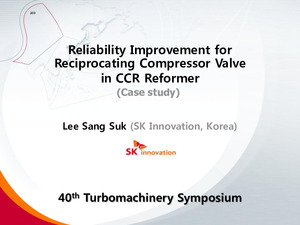Reliability Improvement For Reciprocating Compressor Valve In CCR Reformer (Case Study)
Abstract
Background: After revamp of reformer CCR process where all three compressors are running without stand-by, compressor valve life decreased drastically from 1 year to a few(2~3) months. Troubleshooting: Whole entire factors were investigated from process condition change, piping layout, separating drum size and valve design. Very viscous and sticky heavy hydrocarbon called `Green Oil’ was found at the valves & cylinder could cause valve late closing and consequential excessive impact stress during valve closing. Increased colder spill-back by-pass flow could cool down gas after separator drum made easy formation of heavy hydrocarbon condensate. Moreover liquid condensate could exist as slug at low point of suction manifold piping directly connected to compressor suction. Valve dynamics and pulsation after revamp was acceptable but plate type valve seemed to be not good choice under service including sticky liquid showing bouncing at edge of plate during late closing. Solution implementation and Result: Low point drain of compressor suction manifold piping was added for liquid removal and spill-back flow was reduced by running compressors at partial load to reduce condensation by colder by-pass flow. Valve type was changed to poppet type which is known as relatively better for very viscous and sticky liquid service. Detail study and investigation on suction separator showed nothing bad. After all improvement implementation valve life increased to over 1 year. Lesson Learned: This is a case study for valve failure where entire relevant factors were investigated and any failure of each parameter or its combination can reduce valve life. Mechanical engineer should have relevant knowledge(from mechanical even more to process) and capability to organize the knowledge even process to find root cause.
Description
Case Studypg. 269-290
Subject
TurbomachinesCollections
Citation
Suk, Lee Sang (2011). Reliability Improvement For Reciprocating Compressor Valve In CCR Reformer (Case Study). Texas A&M University. Turbomachinery Laboratories. Available electronically from https : / /hdl .handle .net /1969 .1 /162998.


